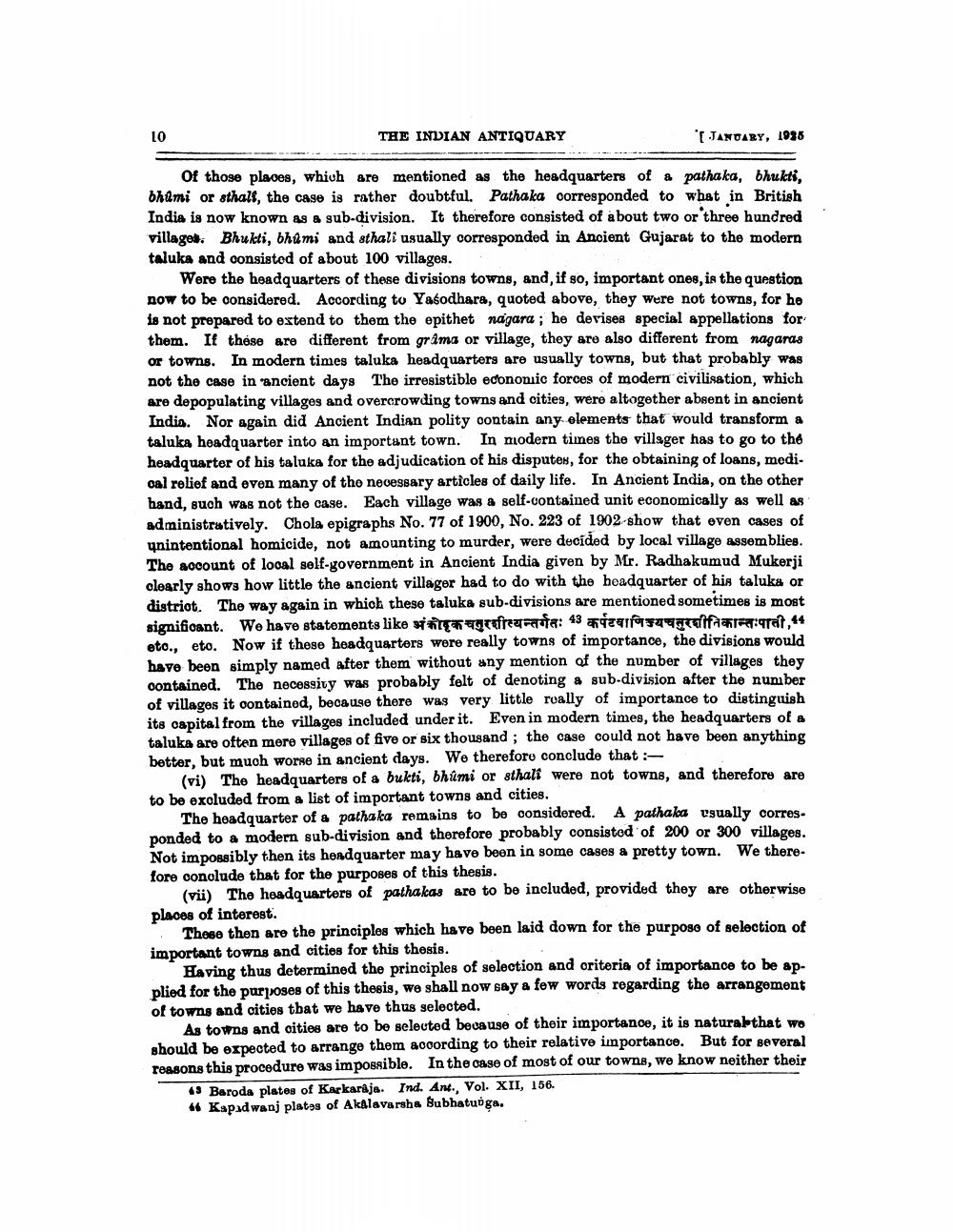________________
THE INDIAN ANTIQUARY
JANUARY, 1938
of those places, which are mentioned as the headquarters of a pathaka, bhukti, bhami or sthall, the case is rather doubtful. Pathaka corresponded to what in British India is now known as a sub-division. It therefore consisted of about two or three hundred village. Bhukti, bhumi and sthali usually corresponded in Ancient Gujarat to the modern taluka and consistod of about 100 villages.
Were the headquarters of these divisions towns, and, if so, important ones, is the question now to be considered. According to Yasodhara, quoted above, they were not towns, for he is not prepared to extend to them the epithet nagara; he devises special appellations for them. If these are different from grama or village, they are also different from nagaras or towns. In modern times taluka headquarters are usually towns, but that probably was not the case in ancient days The irresistible econoniic forces of modern civilisation, which are de populating villages and overcrowding towns and cities, were altogether absent in ancient Indis. Nor again did Ancient Indian polity contain any elements that would transform a taluka headquarter into an important town. In modern times the villager has to go to the headquarter of his taluka for the adjudication of his disputes, for the obtaining of loans, medical relief and even many of the necessary articles of daily life. In Ancient India, on the other hand, such was not the cage. Each village was a self-contained unit economically as well as administratively. Chola epigraphs No. 77 of 1900, No. 223 of 1902-show that even cases of unintentional homicide, not amounting to murder, were decided by local village assemblies. The account of local self-government in Ancient India given by Mr. Radhakumud Mukerji clearly shows how little the ancient villager had to do with the headquarter of his taluka or digtriot. The way again in which these taluka sub-divisions are mentioned sometimes is most significant. We have statements like shlygraferata: 43 99949uratara:qrat, 44 etc., eto. Now if these headquarters were really towns of importance, the divisions would have been simply named after them without any mention of the number of villages they oontained. The necessity was probably felt of denoting & sub-division after the number of villages it oontainod, because there was very little roally of importance to distinguish its capital from the villages included under it. Even in modern times, the headquarters of a taluks are often mere villages of five or six thousand; the case could not have been anything better, but much worse in ancient days. We thereforo conclude that:
(vi) The headquarters of a bukti, bhimi or sthali were not towns, and therefore are to be exoluded from a list of important towns and cities.
The headquarter of a pathaka remains to be considered. A pathaka usually corresponded to a modern sub-division and therefore probably consistod of 200 or 300 villages. Not impossibly then its headquarter may have been in some cases a pretty town. We there fore oonolude that for the purposes of this thesis.
(vii) The headquarters of pathakas are to be included, provided they are otherwise places of interest.
Those then are the principles which have been laid down for the purpose of selection of important towns and cities for this thesis.
Having thus determined the principles of selection and criteria of importance to be applied for the purposes of this thesis, we shall now say a few words regarding the arrangement of towns and cities tbat we have thus selected
As towns and cities are to be selected because of their importance, it is naturabthat we should be expected to arrange them according to their relative importance. But for several reasons this procedure was impossible. In the case of most of our towns, we know neither their
19 Baroda plates of Karkaraja. Ind. Ant., Vol. XII, 156. 46 Kapadwanj platos of Akalavarsha Bubhatuoga.




